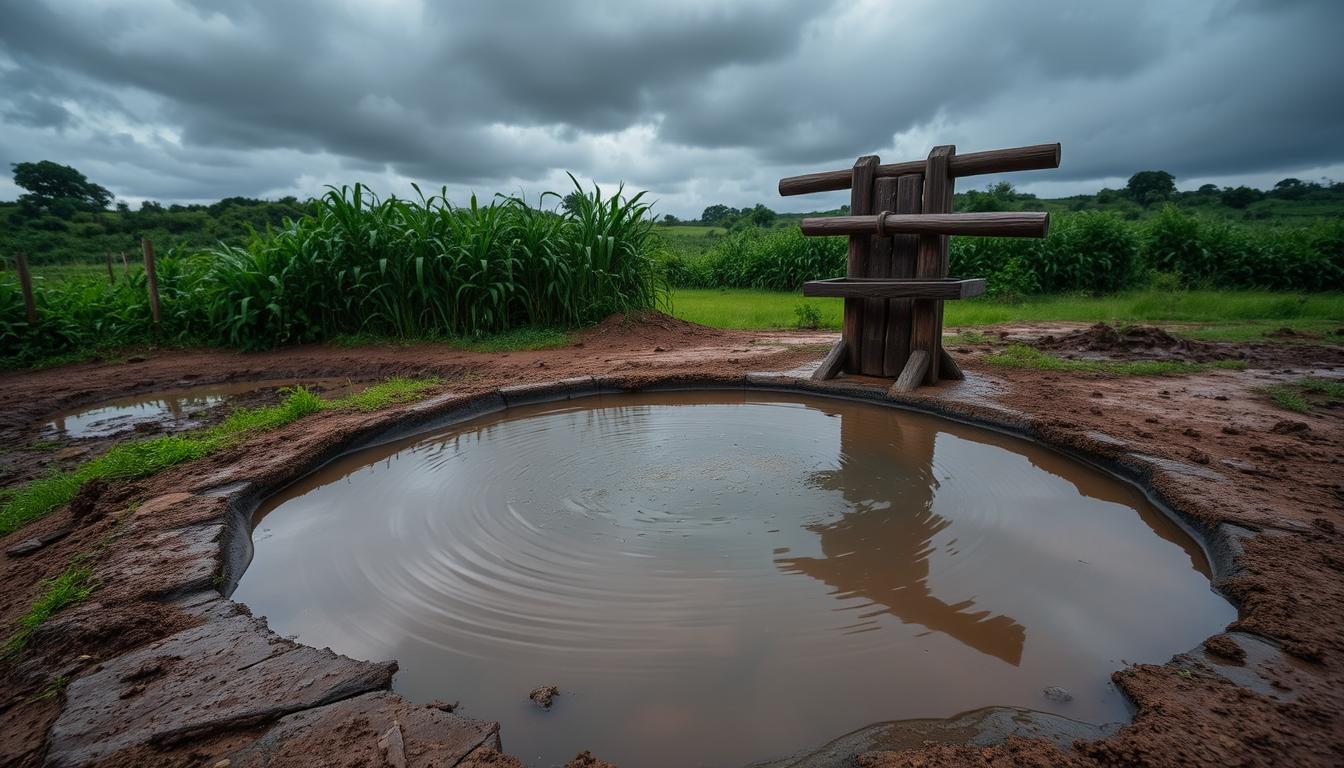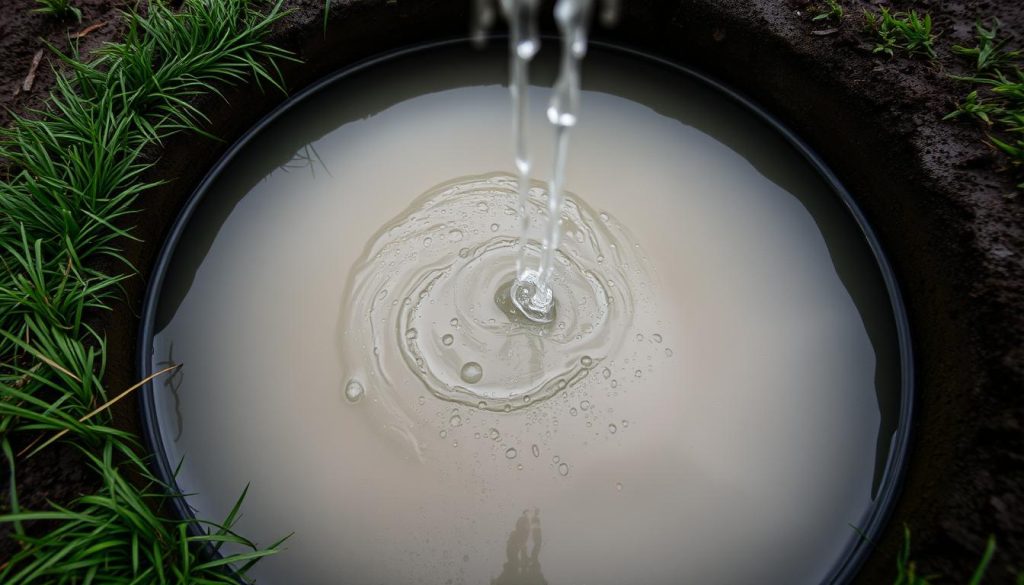
Heavy rain can contaminate well water, increasing the risk of coliform bacteria. This can cause stomach problems and flu-like symptoms. Cloudy water after rain may signal health risks and groundwater contamination.
Discolored well water after rainfall might mean surface water is seeping in. This could bring pesticides, fertilizer, or animal waste. Changes in color, smell, or taste of well water need quick attention.
Sediments in well water include dirt, rust, silt, and other impurities. These may not be harmful, but testing is important. Common particles are clay, iron bacteria, sand, and rock.
Too much iron or manganese can cause discoloration and staining. Iron bacteria may leave black or red sediments in your well water.
Why Does Well Water Turn Cloudy After Heavy Rainfall?
Heavy rainfall can affect well water quality and appearance. Cloudy well water after a downpour can signal underlying issues. Let’s explore the main causes and potential risks of this change in water clarity.

Rainwater Runoff and Surface Water Infiltration
Surface water runoff is a common cause of cloudy well water after heavy rain. Rainwater can pick up contaminants like fertilizers and animal waste as it flows over the ground.
If this contaminated runoff enters the well through cracks, it can lead to water discoloration. This can introduce harmful bacteria like E. coli, posing serious health risks to consumers.
High Sediment Levels and Dissolved Particles
Heavy rainfall can increase sediment levels in well water. Rainwater carries particles like clay, sand, and silt as it seeps into the aquifer.
These particles make water appear cloudy or murky. While not harmful, they may indicate other contaminants like iron bacteria.
| Sediment Particle | Potential Impact on Well Water |
|---|---|
| Clay | Can cause cloudy appearance and harbor bacteria |
| Sand | May contribute to cloudiness and indicate well casing damage |
| Silt | Can make water appear murky and clog filters |
| Rock particles | May indicate well casing damage and allow contaminants to enter |
| Iron bacteria | Can cause reddish-brown stains and potential health issues |
Bacterial Contamination and Septic System Issues
Bacterial contamination is a major concern with cloudy well water after heavy rain. Septic system leaks can introduce harmful bacteria like fecal coliform into the groundwater.
These bacteria can cause severe infections, especially in vulnerable groups. Regular well maintenance and septic inspections are crucial for safe drinking water.
According to the CDC, private well owners should annually test their water for pH, total dissolved solids, nitrates, and coliform bacteria to ensure its safety and quality.
Heavy rainfall can cause cloudy well water due to various factors. Understanding these issues helps maintain safe, high-quality well water. Regular testing and maintenance are key to ensuring your water’s safety.
Addressing Cloudy Well Water After Heavy Rain
Heavy rainfall can lead to cloudy well water. It’s vital to find the cause and ensure your drinking water is safe. Regular testing and maintenance can help tackle this issue effectively.
Proper steps include sealing leaks, fixing damaged parts, and clearing excess air. Disinfecting your well is also crucial to protect your family’s health.
Water Testing and Well Maintenance
Regular water testing is key for safe well water. Professional tests can spot contaminants and suggest treatments. Test your well water yearly for early problem detection.
Good well upkeep prevents surface water from getting in. It also stops bacterial contamination. In Virginia, a steel casing of at least 40 feet helps avoid well collapse.
Sealing Well Leaks and Fixing Damaged Components
Well leaks often come from bad cap seals or poor installation. Fixing these issues is crucial for better water quality. Sealing leaks and repairing damaged parts can stop surface water from entering.
“Surface water leaking into the well is a common cause of discolored water after rain, potentially contaminated with pesticides, fertilizer, or animal waste, emphasizing the need for testing to identify the problem.”
Clearing Excess Air and Dissolved Gases
Air bubbles or dissolved gases can make well water cloudy. Clearing these from your system can improve water clarity. You might need to run taps longer or use special equipment.
Disinfecting Your Well and Water Treatment Options
If tests show bacteria, disinfect your well with bleach or chlorine. Follow state health department and EPA guidelines for proper well cleaning.
Consider adding a water filter system for extra protection. Options like sediment filters and reverse osmosis can remove specific contaminants. These provide an extra layer of safety for your family.
| Treatment Option | Purpose |
|---|---|
| Sediment Filter | Removes suspended particles and sediment |
| Activated Carbon Filter | Reduces organic contaminants, chlorine, and improves taste and odor |
| Reverse Osmosis System | Removes dissolved solids, bacteria, and other contaminants |
| UV Disinfection | Inactivates microorganisms without using chemicals |
Conclusion
Cloudy well water after heavy rain is a common issue. It’s important to understand the causes, like rainwater runoff and high sediment levels. Regular water testing is crucial for identifying contaminants and ensuring well water safety.
To address cloudy water issues, seal well leaks and clear excess air. Disinfect the well as needed. A high-quality water filtration system can remove impurities and ensure clean drinking water.
Direct surface water away from the well to protect it from contamination. Properly maintain well components. Prioritize well water safety and recognize the importance of water filtration.
Stay informed and take preventive measures to address issues promptly. This ensures your well water remains clean, clear, and safe to drink. Even after heavy rainfall, you can maintain high-quality water for your family.







